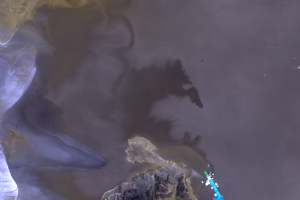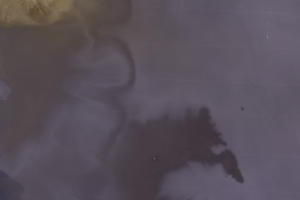If you like being connected to the world everywhere you go with a smartphone or other device, then you have a desolate salt flat in northern Chile to thank.
The salt flat is the Salar de Atacama, one of the largest sources of lithium, a key ingredient in rechargeable batteries. The rectangular shapes in these Landsat images indicate where lithium mining is taking place. The increasing use of smartphones, laptops, and electric cars that use lithium-ion batteries ensures an ever higher demand for the soft, silvery metal.
The salar is in Chile’s Atacama Desert, probably the driest place on the planet. Water leaves the salar only through evaporation, a process that leaves behind salts. The white color around the edge of the salt flat is clay and carbonate-rich material. The center of the salt flat consists of hard crusts of sodium chloride. Under this crust are brines that contain large amounts of lithium, potassium, magnesium, and boron.
Not completely devoid of a water source, the northern part of the basin is the San Pedro River delta. The San Pedro is an ephemeral stream, delivering small amounts of surface water to the basin from the north. The water originates from the Andes Mountains after infrequent storms. These flows form alluvial fans, visible around the fringes of the salt pan.
The scant vegetation appears red in these images, especially around springs at the northern edge of the salt flat. The salt flat itself covers about 3,000 square kilometers, almost the size of Yosemite National Park in California.
Imagery
Every picture has a story to tell
Correlated
Additional story information
Downloads
Berube, D., Diebel, P., Rollin, A., and Stark, T., 2007, Massive mining evaporation ponds constructed in Chilean desert: Geosynthetics. v. 25, p. 26–30, accessed January 25, 2018, at https://www.researchgate.net/publication/289954743_Massive_mining_evaporation_ponds_constructed_in_Chilean_desert.
DMCii, [n.d.], Exploring the Salar de Atacama: DMC International Imaging, accessed January 25, 2018, at http://www.dmcii.com/?p=11712.
ESA, 2017, Salar de Atacama, Chile: ESA, Space in Images, accessed January 25, 2018, at http://www.esa.int/spaceinimages/Images/2017/11/Salar_de_Atacama_Chile.
Goonan, T.G., 2012, Lithium use in batteries: U.S. Geological Survey Circular 1371, 14 p., available at http://pubs.usgs.gov/circ/1371/.
Kampf, S.K., Tyler, S.W., Ortiz, C.A., Muñoz, J.F., and Adkins, P.L., 2005, Evaporation and land surface energy budget at the Salar de Atacama, Northern Chile: Journal of Hydrology, v. 310, p. 236–252, https://doi.org/10.1016/j.jhydrol.2005.01.005.
LithiumMine.com, [n.d.], Lithium Mining in Chile: LithiumMine.com, accessed January 25, 2018, at http://www.lithiummine.com/lithium-mining-in-chile.
Liu, W., Agusdinata, D.B., and Myint, S.W., 2019, Spatiotemporal patterns of lithium mining and environmental degradation in the Atacama Salt Flat, Chile: International Journal of Applied Earth Observation and Geoinformation, v. 80, p. 145-156, https://doi.org/10.1016/j.jag.2019.04.016.
Merchant, B., 2017, The One Device—The Secret History of the iPhone: New York, Little Brown, 416p.
Munk, L.A., Hynek, S.A., Bradley, D.C., Boutt, D., Labay, K., and Jochens, H., 2016, Lithium Brines—A Global Perspective: Reviews in Economic Geology, v. 18, p. 339–365.
National Park Service, [n.d.], Yosemite National Park, California: NPS, accessed January 25, 2018, at https://www.nps.gov/yose/index.htm.
Ogawa, Y., Koibuchi, H., Suto, K., and Inoue, C., 2014, Effects of the Chemical Compositions of Salars de Uyuni and Atacama Brines on Lithium Concentration during Evaporation: Resource Geology, v. 64, no. 2, p. 91–101, doi:10.1111/rge.12030.
Ortiz, C., Aravena, R., Briones, E., Suárez, F., Tore, C., and Muñoz, J.F., 2014, Sources of surface water for the Soncor ecosystem, Salar de Atacama basin, northern Chile: Hydrological Sciences Journal, v. 59, no. 2, p. 336–350, https://doi.org/10.1080/02626667.2013.829231.
Pueyo, J.J., Chong, G., and Ayora, C., 2017, Lithium saltworks of the Salar de Atacama: A model for MgSO4-free ancient potash deposits: Chemical Geology, v. 466, p. 173–186. http://dx.doi.org/10.1016/j.chemgeo.2017.06.005.
Scott, M., 2011, Salar de Atacama, Chile: NASA Earth Observatory, accessed January 25, 2018, at https://earthobservatory.nasa.gov/IOTD/view.php?id=76518.
SQM, 2018, Salar Brines: SQM, accessed January 25, 2018, at http://www.sqm.com/en-us/acercadesqm/recursosnaturales/salmuera.aspx.
Stefanov, W.L., 2010, Evaporation Ponds, Salar de Atacama, Chile: NASA Earth Observatory, accessed January 25, 2018, at https://earthobservatory.nasa.gov/IOTD/view.php?id=42149.
USGS, 2016, Lithium Mining in Salar de Atacama, Chile: USGS Earth Resources Observation and Science (EROS) Center Image of the Week, accessed January 25, 2018, at https://eros.usgs.gov/image-of-the-week/chile-your-smartphone.
Warren, J., 2017, Lithium in saline settings: Salty Matters, accessed January 25, 2018, at http://www.saltworkconsultants.com/blog/lithium-in-saline-settings-1.
Warren, J.K., 2016, Evaporites—A Geological Compendium (2d Ed.): New York, Springer, 1813p.






